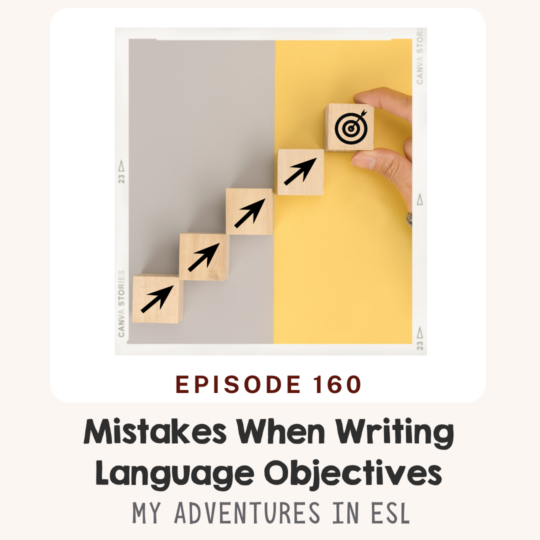
EP 160 3 Common Mistakes ESL Teachers Make When Writing Language Objectives (And How to Fix Them)
Welcome, educators!
Before we dive into today’s post, I want to take a moment to acknowledge the incredible work you do every single day. To all the amazing ESL teachers—thank you. Your heart, your patience, and your dedication make a lasting impact. You do more than just teach English; you empower students to find their voices, express themselves, and build brighter futures.
Your classroom is a place of hope, growth, and possibility. So if you’ve ever felt overwhelmed by the demands of teaching or unsure about certain strategies—know that you are not alone, and support is here for you.
The Importance of Strong Language Objectives
Language objectives are the backbone of effective ESL instruction. They provide a clear, focused roadmap that helps students build both language and content knowledge. But writing them isn’t always easy—especially if you’re new to the process.
I remember feeling completely confused when I started writing language objectives. It was daunting. I often wished I had a step-by-step guide or a graphic organizer to walk me through it. Through a lot of trial and error, I discovered some common pitfalls—and in this post (and the latest podcast episode), I’m sharing what I’ve learned so you can avoid them.
Mistake #1: Using Verbs That Are Not Observable
One of the most common mistakes ESL teachers make is using verbs that aren’t observable in the classroom.
A strong language objective must include action verbs—words that describe something you can see or hear students do. This ensures that the objective is measurable and aligned with student performance.
Example of a Clear Objective:
Listening Objective: “I can listen and label the graph using a word bank.”
The action verbs here are listen and label—both are observable.
When writing your own objectives, ask yourself:
“Can I see or hear this happening in my classroom?”
If the answer is no, it’s time to revise the verb choice.
Mistake #2: Being Too Vague
Another common issue is writing objectives that lack clarity or specificity.
A vague language objective doesn’t give students a clear understanding of what success looks like. For instance:
❌ Vague Objective:
“Students will improve their writing skills.”
This leaves students (and you!) wondering: How? In what way? Using what strategy or focus?
✅ Revised Objective:
“Students will use at least three new adjectives to describe a character in a paragraph.”
This objective is:
- Specific
- Observable
- Measurable
It also aligns with a language function (description) and supports skill development in a focused way.
Mistake #3: Not Including Scaffolds and Supports
The final major mistake is omitting scaffolds—the tools that help English Language Learners access content and language simultaneously.
Language learners often face challenges with academic vocabulary, grammar, and language functions. Scaffolds such as sentence frames, word banks, visuals, and graphic organizers make learning more accessible and meaningful.
❌ Without Scaffolds:
“Students will write a summary of the story.”
✅ With Scaffolds:
“Students will write a summary of the story using a graphic organizer and sentence starters (e.g., ‘The main idea is…’ ‘One important detail is…’).”
By embedding support into your language objectives, you create a learning environment where students can grow with confidence and clarity.
So, How Do You Fix These Mistakes?
Here’s a quick checklist for writing strong language objectives:
✅ Use actionable, observable verbs
✅ Include a specific language function (e.g., predicting, summarizing, comparing)
✅ Provide a measurable outcome
✅ Add scaffolds and supports that meet your students’ needs
Bonus for Educators
Looking for tools that will save you time, engage your students, and simplify your planning?
👉 Click the button below to explore my full collection of engaging ESL resources designed just for you.
Final Thoughts
Every word you teach, every lesson you plan, and every moment you spend encouraging your students matters. Don’t let the complexity of language objectives hold you back. With a few small shifts, you can create goals that drive real progress for your learners.
Keep inspiring, keep growing—and most importantly, keep believing in the work you do.
💙 You are making a difference, one student at a time.




